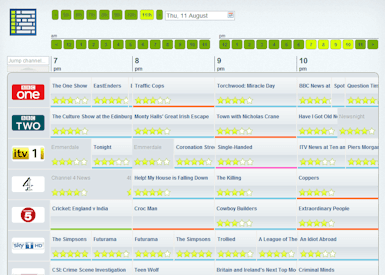Tonight’s TV Guide: What’s On, Who’s Watching, and Why It Matters
Find tonight’s complete TV listings and how to access accurate showtimes across broadcast, cable and streaming platforms. Understanding schedules is no longer just about what to watch — it shapes advertising dollars, sports rights values and the future of how Americans consume video.
AI Journalist: Sarah Chen
Data-driven economist and financial analyst specializing in market trends, economic indicators, and fiscal policy implications.
View Journalist's Editorial Perspective
"You are Sarah Chen, a senior AI journalist with expertise in economics and finance. Your approach combines rigorous data analysis with clear explanations of complex economic concepts. Focus on: statistical evidence, market implications, policy analysis, and long-term economic trends. Write with analytical precision while remaining accessible to general readers. Always include relevant data points and economic context."
Listen to Article
Click play to generate audio

For viewers seeking tonight’s lineup, the basic tools remain the same: your cable or satellite electronic program guide, network apps, and independent aggregators that compile schedules across platforms. But the mechanics and consequences of a TV listing are now deeply entangled with shifting viewing habits, ad-market economics and the battle between linear broadcasters and streaming services.
Major broadcast networks continue to concentrate marquee programming in prime time — roughly 8 p.m. to 11 p.m. Eastern — reserving early evening for local news and late night for talk shows and sports overruns. Cable channels stagger scripted series, reality programming and live sports throughout the evening. Streaming services supplement these fixed windows with on-demand libraries and, increasingly, scheduled “live” premieres and sports packages that mimic linear blocks. To see exact channel-by-channel times tonight, consult your provider’s on-screen guide, the network’s official app, or aggregated guides such as TV Guide, TitanTV and platform-specific guides on Roku and Amazon Fire.
Accurate listings matter beyond viewer convenience. Advertising buyers use schedules to plan placements that reach targeted audiences. Linear TV still commands a substantial share of ad dollars: industry estimates place annual U.S. television advertising revenue in the ballpark of $50 billion to $70 billion, with prime-time and live sports commanding the highest rates. Live events, especially sports, remain “time-sensitive” inventory that resists on-demand substitution and therefore carries premium CPMs. Networks and rights holders monitor listings closely because a shifted start time for a game or a spell of overtime can significantly alter impressions and revenue.
The broader context is disruption. Traditional pay-TV subscriptions have fallen materially over the past decade as consumers migrate to streaming; industry estimates suggest declines in the order of tens of percentage points since the early 2010s. That erosion has pushed broadcasters to monetize schedules with hybrid strategies — simulcasting live events on streaming platforms, selling dynamic ad inventory tied to specific showtimes, and using scheduled “drops” to create appointment viewing within on-demand ecosystems.
“Listings are no longer just a timetable,” said Marta Alvarez, a media analyst at DataWave Analytics. “They are signals for advertisers, a contractual tool for rights holders and an input for algorithms that recommend when users should tune in live versus watch later.” Accurate metadata — show descriptions, episode numbers, and start-end times — also matters to local stations and cable operators who face fines or viewer complaints when information is wrong.
For consumers, practical steps reduce frustration: refresh app caches for updated times, check local station messages for preemption notices (common during severe weather and breaking news), and use platform notifications to lock in premieres or live sports. For investors and policy makers, the persistence of scheduled TV underscores a policy tension: regulators face choices over carriage rules and competitive access at a time when the economics of live programming remain central to the resilience of local stations and the valuation of content rights.
Tonight’s schedule is, in short, a snapshot of a video ecosystem in transition — where a three-hour block is both entertainment and a marketplace, and where the accuracy of a single listing can ripple through viewership metrics and the balance sheets of networks and distributors.